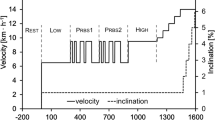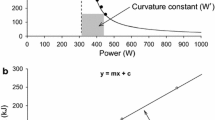Abstract
In order to follow the time pattern of oxygen uptake and recovery for supramaximal work of short duration, 35 male subjects (mean age 21.4 years, mean body weight 71.9 kg) pedalled a bicycle ergometer at maximal speed for 1 min. A constant frictional resistance of 5.5 kg was used, resulting in a total work output of 2890 kpm (85 revolutions, SD = 7.5). The total percent decrement in work output from the initial rate on this test was 59.7 %. The total oxygen uptake during the work averaged 2.35 l, the net oxygen recovery was 4.891, while the net work efficiency was 19.3 %. One and two component exponential curves fit the observed oxygen uptake and recovery measures with a high degree of accuracy. Comparison of the curve parameters with published data showed large differences for the post exercise oxygen recovery and the slow component of the recovery curve. The magnitude of the fast component of recovery was similar to other data. The total oxygen uptake during the test was found to be 10% lower than the maximal oxygen uptake determined on a seperate progressive step-increment test. It was shown, by curve analysis, that the maximal oxygen uptake would have been reached in approximately 2 min.
Similar content being viewed by others
References
Alpert, N. R.: Lactate production and removal and the regulation of metabolism. Ann. N.Y. Acad. Sci.119, 995–1012 (1965).
Berg, W. E.: Individual differences in respiratory gas exchange during recovery from moderate exercise. Amer. J. Physiol.149, 597–610 (1947).
Brooks, G., Hittelman, K. J., Faulkner, J. A., Beyer, R. E.: Tissue temperature and whole-animal oxygen consumption after exercise. Amer. J. Physiol.221 (2), 427–431 (1971).
Christensen, E. H., Hogberg, P.: The efficiency of anaerobic work. Arbeitsphysiologie14, 249–250 (1950).
Crescitelli, F., Taylor, C.: The lactate response to exercise and its relationship to physical fitness. Amer. J. Physiol.141, 630 (1944).
Cureton, T. K.: Physical fitness of champion athletes. Urbana: The University of Illinois Press 1951.
De Moor, J. C.: Individual differences in oxygen debt curves related to mechanical efficiency and sex. J. appl. Physiol.6, 460–466 (1954).
Di Prampero, P. E., Davies, C. T. M., Cerretelli, P., Margaria, R.: An analysis of O2 debt contracted in submaximal exercise. J. appl. Physiol.29, 547–551 (1970).
Henry, F. M.: Aerobic oxygen consumption and alactic debt in muscular work. J. appl. Physiol.3, 427–438 (1951).
Henry, F. M.: The oxygen requirement of walking and running. Res. Quart. Amer. Ass. Hlth phys. Educ.24, 169–175 (1953).
Henry, F. M.: Reliability, measurement error and intraindividual differences. Res. Quart. Amer. Ass. Hlth phys. Educ.30, 21–24 (1959).
Henry, F. M., Berg, W. E.: Physiological and performance changes in athletic conditioning. J. appl. Physiol.3, 103–111 (1950).
Henry, F. M., DeMoor, J.: Metabolic efficiency of exercise in relation to work-load at constant speed. J. appl. Physiol.2, 481–487 (1950).
Henry, F. M., DeMoor, J.: Lactic acid and alactic oxygen consumption in moderate exercise of graded intensity. J. appl. Physiol.8, 608–614 (1956).
Henry, F. M., DeMoor, J. C., Trafton, I. R.: Individual differences in oxygen metabolism of work at two speeds of movement. Res. Quart. Amer. Ass. Hlth phys. Educ.22, 324–333 (1951).
Hill, A. V., Long, C. N. H., Lupton, H.: Muscular exercise, lactic acid, and supply and utilization of oxygen, Parts IV-VI. Proc. roy. Soc. B97, 84–138 (1924).
Katch, V.: Correlation vs. ratio adjustment of body weight in exercise-oxygen studies. Ergonomics15 (6), 671–680 (1972).
Katch, V., Henry, F. M.: Prediction of running performance using maximal oxygen debt and intake. Med. and Sci. in Sports4 (4), 187–191 (1972).
Katch, F. I., Girandola, R. N., Henry, F. M.: The influence of the estimated oxygen cost of ventilation on oxygen deficit and recovery oxygen intake for moderately heavy bicycle ergometer exercise. Med. and Sci. in Sports4 (2), 71–76 (1972).
Knuttgen, H. G.: Oxygen debt, lactate, pyruvate, and excess lactate after muscular work. J. appl. Physiol.17, 639–644 (1962).
Knuttgen, H. G.: Oxygen debt after submaximal physical exercise. J. appl. Physiol.29 (5), 651–657 (1970).
Margaria, R., Cerretelli, P., Aghemo, P., Sassi, G.: Energy cost of running. J. appl. Physiol.18, 367–370 (1963).
Margaria, R., Cerretelli, P., di Prampero, P. E.: Energy utilization in intermittent exercise of supramaximal intensity. J. appl. Physiol.26, 752–756 (1969).
Margaria, R., Cerretelli, P., di Prampero, P. E., Massari, C., Torelli, G.: Kinetics and mechanism of oxygen debt contraction in man. J. appl. Physiol.18, 371–377 (1963).
Margaria, R., Edwards, H. T.: The sources of energy in muscular work performed in anaerobic conditions. Amer. J. Physiol.108, 341–348 (1934).
Margaria, R., Edwards, H. T., Dill, D. B.: The possible mechanism of contracting and paying the oxygen debt and the role of lactic acid in muscular contraction. Amer. J. Physiol.106, 689–715 (1933).
Piiper, J., di Prampero, P. E., Cerretelli, P.: Oxygen debt and high-energy phosphates in gastrocnemius muscle of the dog. Amer. J. Physiol.215, 523–531 (1968).
Royce, J.: Active and passive recovery from maximal aerobic capacity work. Int. Z. angew. Physiol.28, 1–8 (1969).
Stainsby, W. N., Welch, H. G.: Lactate metabolism of contracting dog muscle in situ. Amer. J. Physiol.211, 177–183 (1966).
Tanner, J. M.: Fallacy of per-weight and per-surface area standards, and their relation to spurious correlation. J. appl. Physiol.2 (1), 1–15 (1949).
Wasserman, K., Burton, G. G., Van Kessel, A. L.: Interactions of physiological mechanisms during exercise. J. appl. Physiol.22, 71–85 (1967).
Welch, H. G., Faulkner, J. A., Barclay, J. K., Brooks, G. A.: Ventilatory response during recovery from muscular work and its relation with O2 debt. Med. and Sci. in Sports2, 15–19 (1970).
Whipp, B. M., Seard, C., Wasserman, K.: Oxygen deficit-oxygen debt relationships during exercise. Physiologist12, 391 (1969).
Whipp, B. M.: Rate constant for the kinetics of oxygen uptake during light exercise. J. appl. Physiol.30 (2), 261–263 (1971).
Author information
Authors and Affiliations
Rights and permissions
About this article
Cite this article
Katch, V.L. Kinetics of oxygen uptake and recovery for supramaximal work of short duration. Int. Z. Angew. Physiol. Einschl. Arbeitsphysiol. 31, 197–207 (1973). https://doi.org/10.1007/BF00697599
Received:
Issue Date:
DOI: https://doi.org/10.1007/BF00697599




